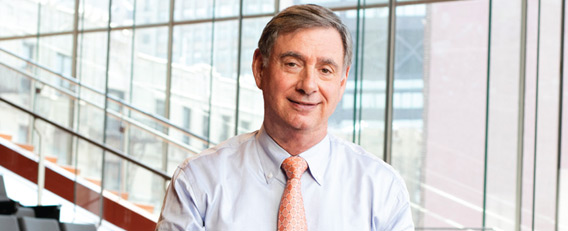A 14-Year Partnership: ‘Honored and Privileged to be the Temporary Steward’
SHORTLY AFTER ARRIVING AT COLUMBIA IN 2006 as dean of what has since been renamed the Vagelos College of Physicians and Surgeons, Lee Goldman sat down with Columbia Medicine and outlined his vision for working with faculty, students, staff, alumni, and other supporters to pursue multiple goals: “have a curriculum that everyone else emulates,” “change the way the place looks,” “make substantial investments in the academic mission,” “build new strengths,” and “aggregate talent.”
An interview this year gave Dr. Goldman an opportunity to reflect on his 14 years as “temporary steward” of VP&S. What follows is a condensed version of the conversation.
COLUMBIA MEDICINE: Much of the success during your tenure started with building a financial model that provided financial security.
LEE GOLDMAN: It is very important to emphasize that financial stability is not an end in itself but a means to an end. We are not a publicly traded entity whose success is largely linked to its profit margin, but we have to be prudent and responsible. Our greatness is not based on the size of the margin but rather on how we prioritize our resources. If we always lose money, we cannot make the investments needed for greatness. Financial stability has fueled investments that have stimulated rapid growth in both research and our clinical programs and made us much more attractive to students and philanthropists.
You also have referred to campus improvements as a means to an end.
Poor facilities are a disincentive for good people to join us and, frankly, even for good people to stay. We don’t need fancy facilities, but we do want to have a campus that is a draw for students, faculty, patients, and staff who are proud to be here. Many of our buildings are old, but even they can be appealing if they look good and function well. Part of the appeal is our historic position of being among the very first places where a medical school and a hospital came together to create an academic medical center. I am always impressed that if you look at this campus from any direction, the size and scale of the buildings are truly remarkable. Even the oldest ones have good “bones” so they can be renovated to create first-class offices and laboratories suitable for the modern era, and our financial stability has allowed us to do just that.
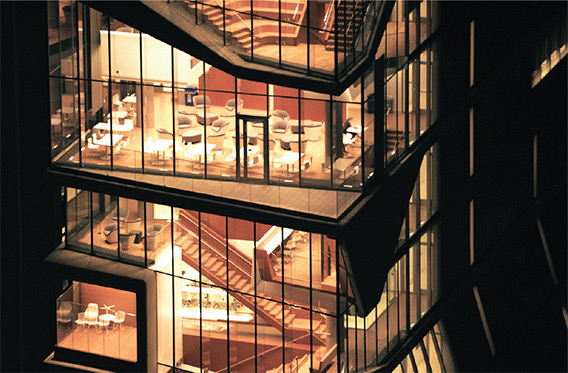
How have we done in terms of aggregating talent?
The real measure of how we are doing is our ability to aggregate talent, to bring terrific people here as trainees, faculty, and staff and to mentor them and help them succeed. Our people make us a great place, so everything we do is with that goal in mind. We value people who are or will become local, regional, national, and international leaders in all of our missions. We also value diversity and inclusion, people from all backgrounds. We are at the top of our peer group in terms of the percentage of women faculty, and we are committed to assuring that tenure, tenure track, and leadership positions represent our belief in diversity and inclusion. We owe a great deal to Dr. Anne Taylor, vice dean for academic affairs, for how she has helped us—she has been a real leader here and nationally.
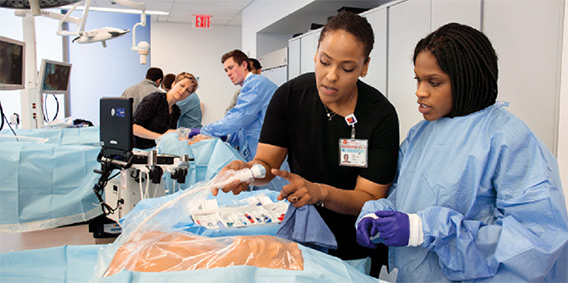 Julia Iyasere, MD, left, works with a student in the simulation center in the Vagelos Education Center. Photo by Jörg Meyer.
Julia Iyasere, MD, left, works with a student in the simulation center in the Vagelos Education Center. Photo by Jörg Meyer.How does the concept of a means to an end relate to education?
Early on, we worked on the medical school curriculum, to modernize it, to create a curriculum in which students completed their pre-clerkship requirements more rapidly and saw patients right from the beginning. The new curriculum emphasized small groups and created time needed for students to complete a scholarly project. These changes, which made the medical school experience more positive, set the stage for similar changes in many of our peer schools.
And, of course, the scholarship program is a game changer. Thanks to the extraordinary generosity of Roy and Diana Vagelos as well as matching gifts from numerous alumni, friends, and faculty, we now can provide all calculated financial need as scholarships without loans. And now we can fully cover the expenses of students who come from families that have less than $125,000 in annual income. These scholarships are making medical school affordable for people who previously would not even think about applying. Our hope is that this financial aid will allow our students to pursue careers in fields such as primary care, pediatrics, and research, where remuneration is lower, because they will not be limited by medical school debt.
How does research measure up?
An emphasis on research is one of the things that fundamentally differentiates academic medical centers from other good hospitals and medical practices. We have made investments in both basic and clinical research, and our 2019 ranking in Nature Index, an annual calculation of research citations, is a marker of our success: Last year we were No. 1 in the United States! Another metric is the growth over the past decade of our National Institutes of Health grants portfolio, which at the conclusion of the last federal fiscal year had the third largest absolute growth of any medical school in the country and the largest percentage growth of any of the top 10 schools. We have had a number of initiatives to expand our research portfolio, including genomic medicine, systems biology, computational biology, immunology, cancer, and stem cell biology. Clinical trials continue to expand and contribute to some of the most important medical advances of our time. During the height of this year’s coronavirus pandemic, we were able to pivot quickly to research that approaches COVID-19 from multiple angles. At press time, that work continues and includes the development of new diagnostic tests, the use of such tests to track the early and subsequent spread of the virus, and the identification of novel therapeutic targets. We are confident our researchers will be at the forefront of innovations in diagnosis, treatment, and prevention that will contribute to a successful response to this pandemic.
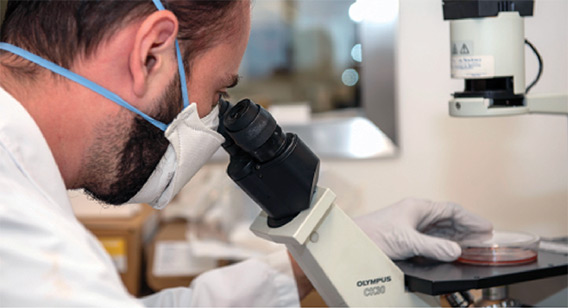 Soon after moving to VP&S in early 2020, the Aaron Diamond AIDS Research Center pivoted to COVID-19 research projects.
Soon after moving to VP&S in early 2020, the Aaron Diamond AIDS Research Center pivoted to COVID-19 research projects.Being a part of a great university has enabled us to share resources and expertise, as well as to recruit and retain talented faculty and trainees and help catalyze research programs in other schools or campuses. The Zuckerman Mind Brain Behavior Institute is a multidisciplinary program that includes many outstanding members of the VP&S faculty. We have a wonderful relationship with the engineering school, where our faculty work especially closely with faculty in the Department of Biomedical Engineering. The same can be said of precision medicine and cancer, which are more and more Columbia-wide programs and not just based at the medical center.
Patient care?
Our faculty provide outstanding patient care and have expanded programs in Manhattan, with our major facility at 51st Street, as well as other locations. With NewYork-Presbyterian, we have also had major expansion in Westchester County, especially at Lawrence Hospital in Bronxville. The clinical growth has been driven by the fact that patients all over the New York metropolitan area want to see Columbia doctors, so it is gratifying that we can connect our terrific doctors with patients to provide truly exceptional care. This growth is possible only because of the wonderful partnership we have with NewYork-Presbyterian. The hospital has made a huge investment not only in clinical care but also in key aspects of education and research that underscore our combined ability to be a top provider of clinical care. Being associated with a highly ranked hospital reflects well on us, and our highly ranked medical school in turn helps the hospital.
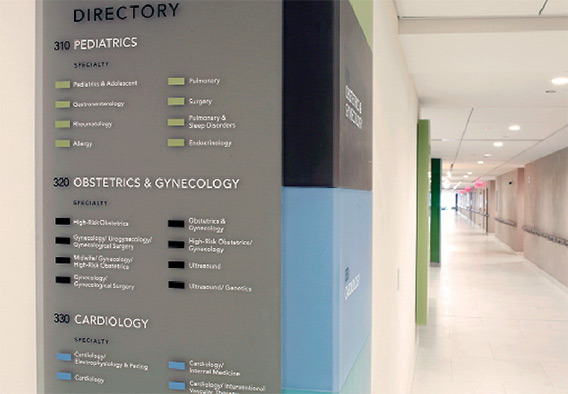 ColumbiaDoctors Midtown, which opened in 2013, is part of the growth and expansion of clinical practices in recent years.
ColumbiaDoctors Midtown, which opened in 2013, is part of the growth and expansion of clinical practices in recent years.More recently, our faculty, staff, and even students have risen—often with true heroism—to face the COVID-19 pandemic. With NewYork-Presbyterian, we have pioneered approaches, such as shared ventilators, have been leaders in clinical trials, and have achieved remarkable outcomes even in the sickest of patients.
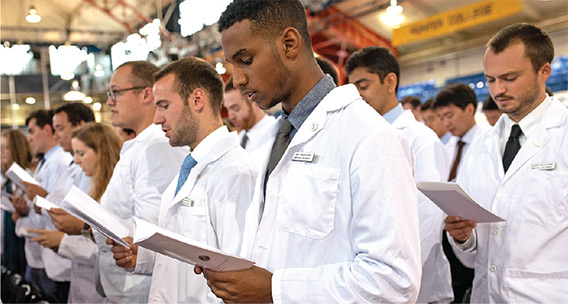
How has philanthropy been a means to an end?
Just as the generosity of Roy and Diana Vagelos was a game changer for our students by providing scholarships, other gifts have been “name” changers. The estate of Herbert and Florence Irving provided support for cancer, translational research, precision medicine, and young faculty scholars, and we joined NewYork-Presbyterian Hospital in renaming the medical center in recognition of the role the Irvings played in advancing what is one of the leading academic medical centers in the nation and world. And, of course, the generosity of Roy and Diana Vagelos went far beyond creating our scholarship program. Their gifts also support precision medicine and basic science research programs. Their total giving to Columbia—$310 million, including the donation they provided for the design and construction of the award-winning Vagelos Education Center—has been transformative, particularly when added to the matching funds generated through their giving. Overall, VP&S has raised nearly $3 billion over these past 14 years.
The generosity of so many individuals and organizations—and the continuing support of our research by the NIH, the devotion of our patients, the popularity of our medical school among applicants, the wonderful pool of talent among our faculty and staff, and the devotion of our alumni—will ensure that this medical school will remain among the very best in the nation and the world for many generations to come. It has been an honor and privilege to be the school’s temporary steward through these past 14 years.
When I started medical school in 2004, Columbia was already a powerhouse. Lee’s stellar leadership in the past 14 years has led Columbia Vagelos College of Physicians and Surgeons to grow and progress to, in my honest opinion, the best medical school in the country.
— Thomas Lo’08
President, VP&S
Alumni Association
Lee Goldman has been an extraordinary dean. Not only because he moved our school out of a blood-red deficit in a matter of years. Not only because he threw open the doors of innovation in our medical curriculum. Not only because he offered to build a new Department of Medical Humanities & Ethics and invited me to chair it. But because he has the rare-to-vanishing leadership capacity to birth great visions and then make them happen.
— Rita Charon, MD, PhD
Professor and Chair, Medical Humanities & Ethics; Professor of Medicine; and Executive Director, Columbia Narrative Medicine
From the moment I met Dean Goldman, I knew he would be an outstanding leader for our medical school, our campus, and the northern Manhattan community. Lee was always cognizant of persistent health disparities in the community and the role of the institution in improving the quality of life and social determinants of health of our neighbors. He came to be known in our community as a trusted leader and supporter of the community’s health agenda.
— Rafael Lantigua, MD
Director, Office of Community Service Programs
Under Dean Goldman’s leadership we were able to bring our medical school and medical school curriculum to the next level. The new education building with its state-of-the-art simulation center and modular classrooms has provided new, incredible opportunities for teaching and learning. I felt truly supported as a medical educator. Thanks to Dean Goldman’s vision, medical students are more prepared than ever to practice medicine.
— Rachel J. Gordon, MD
Associate Professor of Medicine and Epidemiology at CUMC; Director, Curricular Innovation & Strategic Initiatives; and Course Director, Ready 4 Residency
Lee Goldman has been deeply committed to recruiting the most talented and diverse faculty in the history of VP&S. But perhaps more admirable is that he made support of faculty professional development, accommodation for family priorities, and celebration of faculty achievements a benchmark of his tenure as dean.
— Anne Taylor, MD
Vice Dean for Academic Affairs
My primary reason for accepting a faculty position at Columbia in 2008 was the exciting new 18-month basic science curriculum implemented by Dr. Goldman. This change allowed me to transform the gross anatomy course into one that emphasizes teamwork and small group learning.
— Paulette Bernd, PhD
Professor of Pathology & Cell Biology and Director, Clinical Gross Anatomy & Anatomical Donor Program
The past 14 years have seen a revolution in structural biology with the addition of electron microscopy as a tool of molecular structure determination. The dean’s decisive steps to build up a cryo-EM resource facility with the help of generous donors have propelled Columbia University to the forefront of structural biology and precision medicine worldwide.
— Joachim Frank, PhD
Professor of Biochemistry & Molecular Biophysics and 2017 Nobel Laureate
Dean Goldman has shown exemplary support of the research mission and appreciation for the dedication and accomplishments of the faculty. He has enhanced resources for achieving excellence in fundamental and translational research, improved the environment through programs for faculty development and inclusion, and rewarded achievement at all levels.
— Donna Farber, PhD
George H. Humphreys II Professor of Surgical Sciences (in Surgery) and Professor of Microbiology & Immunology
By any measure—grants, philanthropy, space, practice volume, education, recruitment— Dr. Goldman has changed the face of VP&S in a very positive way.
— Thomas Q. Morris, MD
Alumni Professor Emeritus of Clinical Medicine and Interim Dean for Clinical and Educational Affairs, 2000-2001
Under Lee’s guidance, ColumbiaDoctors has grown exponentially. His advocacy enabled the Faculty Practice Organization to fulfill its mission of providing centralized services and professional support for our clinical operations throughout the region. It is because of Lee that we’ve been able to enhance the quality of patient care and have ensured a more uniform patient experience for every person who sees a Columbia doctor. Thanks to Lee’s visionary leadership, we successfully developed multispecialty practices from Manhattan to northern Westchester.
— George A. “Jack” Cioffi, MD
Edward S. Harkness Professor, Jean and Richard Deems Professor; Chair, Ophthalmology; and President, ColumbiaDoctors
Strange fate. I got the honor to be recruited twice by Dr. Goldman. First at UCSF, when he was chairman of the Department of Medicine, to be one of the first junior faculty recruited to the newly established stem cell program. Then, in 2017, to take the direction of the Columbia Stem Cell Initiative in VP&S. I was always attracted by Dr. Goldman’s modern vision of the biomedical enterprise and joined VP&S to help place stem cell research at the center of it.
— Emmanuelle Passegué, PhD
Director, Columbia Stem Cell Initiative, and Alumni Professor of Genetics & Development
As a bioengineer with a lab at CUIMC and appointments at the Department of Medicine and the College of Dental Medicine, I benefited from the intellectually rich and highly collaborative environment for translational research. Dean Goldman deserves a lot of credit for facilitating interactions between CUIMC and engineering and for promoting research focused on real clinical needs.
— Gordana Vunjak-Novakovic , PhD
University Professor; Mikati Foundation Professor of Biomedical Engineering and Medicine; Professor of Dental Medicine; and Director, Laboratory for Stem Cells and Tissue Engineering
Dr. Goldman is a renowned clinical epidemiologist and an inspiring mentor. It is hard to overstate his impact on the extraordinary growth of clinical research programs across the schools and departments at CUIMC. As a member of the first cohort of faculty recruited to Columbia by Dr. Goldman, I feel extremely fortunate and honored to serve the institution under his tutelage. Thanks to his support and guidance, Columbia has become an academic powerhouse of perioperative outcomes research and injury epidemiology.
— Guohua Li, MD, DrPH
Mieczyslaw Finster Professor of Anesthesiology
I have had the opportunity to witness the evolution of VP&S since 1999 when I arrived as a medical student. The appearance of the school has been markedly enhanced, the resources to support research by younger investigators have increased, and there is more transparency in the promotion process for faculty.
— Richard O. Francis, MD, PhD Assistant Professor of Pathology & Cell Biology
Dean Goldman instilled in me his goal that VP&S be “in the top 5, arguably the best.” This challenge to us inspired me to make that happen in our department. I am enormously grateful for his support in making it real.
— Mary D’Alton, MD
Willard C. Rappleye Professor and Chair, Obstetrics & Gynecology
Lee Goldman is an amazing person. He’s a scholar. He’s a researcher. And he has made enormous contributions to patient health, outcomes, and systems wherever he’s been. He has contributed to every aspect of the medical school and the medical center.
— P. Roy Vagelos’54
Chair, Board of Advisors
Having arrived at Columbia in 2007, I clearly recall that the campus lacked a physical glow. The solid old buildings on 168th Street looked rather worn. The newer buildings were at the campus perimeter, hence not as visible. Since then, the campus has developed a sense of modernity in the architectural splendor of the Vagelos building, the new glassy front meeting area of the P&S building (looking more like Lincoln Center), and the greenery and car-free zone of Haven Plaza. These changes are not simply skin deep. They epitomize the transformation of the CUIMC campus: physically, culturally, intellectually. CUIMC looks–and is–exciting! The other major change is that collegial supportive behavior among faculty, trainees, staff, and with patients has become what is expected. Diversity is now supported and celebrated, as we now expect in our modern world and at CUIMC.
— Nancy S. Green, MD
Professor of Pediatrics at CUMC
Lee Goldman has been a transformative leader for Columbia’s medical center for 14 years. His truly remarkable tenure for a medical school dean is a testament to his skills in not only establishing a model system that has ensured the fiscal health of our schools but has supported spectacular growth of the clinical, educational, and research enterprises. On a personal level I am grateful for the support Lee has provided for the scientific programs that have been incredibly productive and have solidified Columbia’s position as a leader worldwide in biomedical research.
— Andrew R. Marks, MD
Wu Professor and Chair, Physiology & Cellular Biophysics
Lee, arriving during dark days of massive financial hemorrhage, creatively staunched the bleeding as he engaged the self-interest of faculty to control costs and increase revenue. Like clockwork, transformative research and clinical growth, epic philanthropy and novel initiatives all followed in time for our 250th!
— Donald Landry, MD, PhD
Samuel Bard Professor of Medicine, Hamilton Southworth Professor of Medicine, and Chair, Medicine
I arrived at Columbia in in 2007 just a short time after Lee had become dean. I had been encouraged to move to Columbia by a senior colleague from UCSF (where Lee had been chair of medicine) who told me that he anticipated that Lee would do great things at Columbia. And surely has. I have learned a lot from Lee’s steady leadership over so many years. Most importantly, I appreciate his tremendous integrity and unwavering vision of excellence. I have watched from the sidelines as Lee made tough decisions that he thought would be best for our institution and then unwaveringly supported and defended them. I cannot say that I agree with every decision Lee made but I truly respect the leadership that he consistently demonstrated over many years. I know that we (at the medical school) are all better as a consequence of his tenure.
— Cory Abate-Shen, PhD
Professor and Chair, Pharmacology
Dr. Goldman, a truly inspiring visionary, has fostered a space where multidisciplinary, interdepartmental, and multicampus research initiatives have led to groundbreaking medical discoveries and advances that could have only happened here at Columbia University Irving Medical Center.
— Dominique D. Bailey, MD
Instructor in Pediatrics
14 Years of Progress, Growth
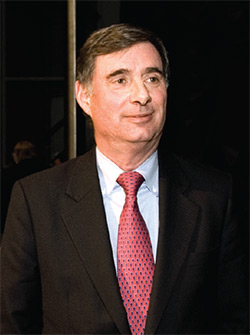 2006
2006
Lee Goldman becomes the 23rd dean in the history of the Vagelos College of Physicians and Surgeons.
$54 million NIH grant and private funding create the Irving Institute for Clinical and Translational Research.
2007
New financial and administrative model is launched to ensure financial stability.
The Department of Neuroscience is the first of four new departments established between 2006 and 2020. Emergency Medicine, Systems Biology, and Medical Humanities & Ethics are the others.
 2008
2008
Joachim Frank, 2017 Chemistry Nobel Laureate, joins VP&S faculty.
2009
30,000-square-foot Hammer Teaching and Learning Center opens.
New curriculum is launched with the incoming Class of 2013, shortening the fundamentals, moving patient care to the beginning of medical school, and adding a scholarly project requirement.
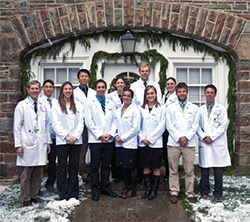 2010
2010
$50 million gift from Roy and Diana Vagelos supports construction of a new education building.
First students enroll in the Columbia-Bassett Program, in which students begin their studies in New York City then move to Bassett Medical Center to care for patients in a mostly rural population.
2011
Strategic planning process, “2020 Vision,” begins.
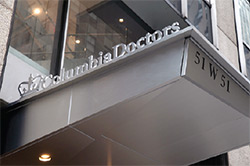 2013
2013
New outpatient facility in Midtown opens at 51 W. 51st St.
A new degree, a three-year PhD-to-MD degree, is offered.
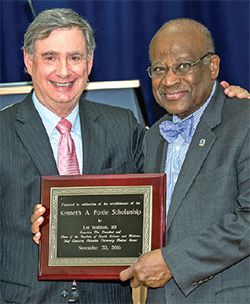 2014
2014
Virginia Kneeland Frantz Society for Women Faculty is established.
Kenneth A. Forde Diversity Alliance is established.
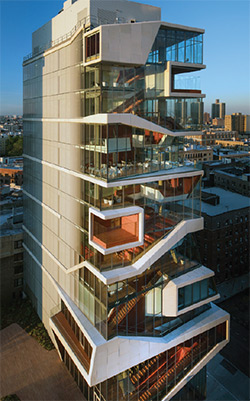 2016
2016
Gifts from Florence and Herbert Irving lead to renaming the medical center as the Columbia University Irving Medical Center.
The award-winning Roy and Diana Vagelos Education Center opens on Haven Avenue. It includes five floors of a simulation center, the medical school’s first dedicated space for simulated learning.
 2017
2017
Columbia University renames its 250-year-old medical school the Roy and Diana Vagelos College of Physicians and Surgeons.
VP&S, which started life in 1767 as the medical faculty of King’s College (which later became Columbia University), celebrates
its 250th anniversary.
2018
VP&S announces a program that provides scholarships in place of loans for all students with financial need.
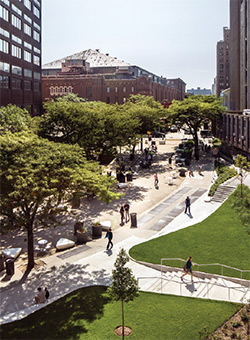 2019
2019
Haven Plaza, 60,000 square feet of space on Haven Avenue, opens to provide quality open space for the medical center community and the surrounding neighborhood.
For the past decade, VP&S has had the third largest absolute increase in NIH grants dollars and the largest percentage increase in the top 10 medical schools.
Columbia University Irving Medical Center is named the top health care institution for scientific research by the Nature Index Annual Tables.
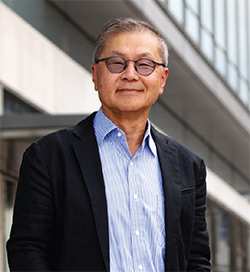 2020
2020
Aaron Diamond AIDS Research Center, led by David Ho, moves from Rockefeller University to VP&S.
- Log in to post comments


